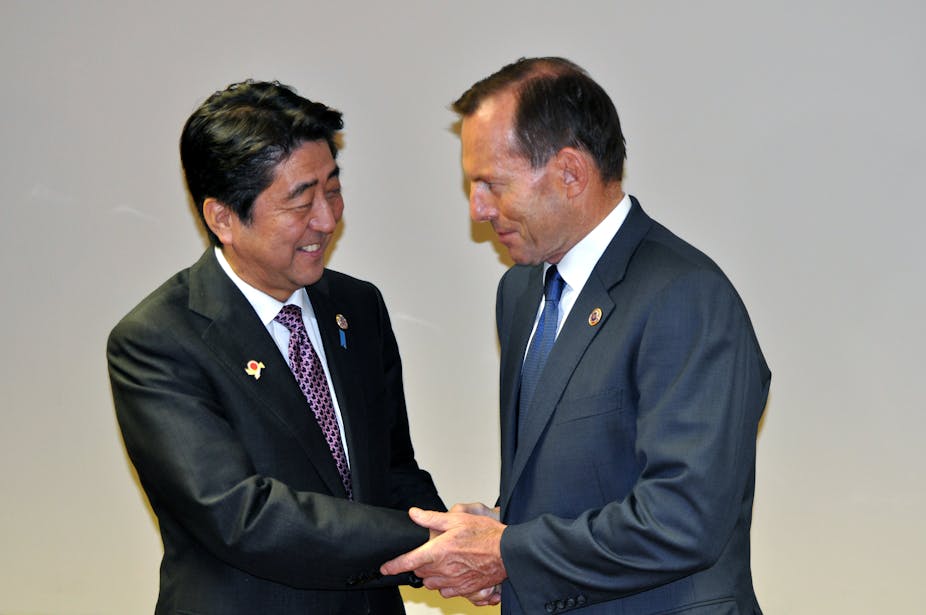A new right-wing nationalism with the potential to reshape the region’s politics has emerged in Asia. This is evident over the last couple of years in the election of Shinzo Abe in Japan, Geun-Hye Park in South Korea and even Tony Abbott in Australia. They will soon be joined by Narendra Modi in India, if the pundits are correct.
Abe has most clearly articulated this nationalism. He made a statement with his controversial visit to the Yasukuni shrine where Japanese war dead, including those deemed war criminals during World War Two, are interred. This is a nationalism that seeks a return to what is perceived as a timeless form of cultural community.
Similarly, BJP leader Modi – who many hold responsible for attacks on Muslims in his home state of Gujarat – has reinforced the party’s emphasis on the Hindu historical and cultural community.
The emerging nationalism resurrects some of the region’s older authoritarian ideologies and institutions. Park and Abe have strong family connections to the cold war and developmental states of Korea and Japan. What makes this a “new” Right is that local conservative agendas are set within new geo-economic structures and social forces.
Fighting culture wars across Asia
At the core of this nationalism is the use and manipulation of a cultural stake and appeals to notions of community – Gemeinschaft, to use the sociological jargon.
To give one example: draft changes to Japan’s post-war constitution have focused on Article 9, the pacifist clause. But equally emblematic of the new Right is a proposed change to Article 13, which states that “all of the people shall be respected as individuals”. A seemingly small change to “respected as persons” carries deeper resonance: persons represent “communitarian attachments” to family and nation.
These same illiberal understandings permeate the BJP’s use of Hinduism in India and its exclusionary notions of citizenship. Interestingly, many mainstream conservative parties and movements in Europe and Australia are deploying particular cultural language in opposition to the universalism of individual rights.
Here is the twist: these new Right ideas are often couched – especially against the emergent Chinese power – in terms of western liberal or enlightenment values. The Abe government has used this rhetoric in Japan’s heated territorial dispute with China. On this score, the new Right in Asia differs from previous authoritarian ideologies of East Asia.
Mobilising civic groups on the right
A further important difference is that the new Right seeks to mobilise civic organisations.
South Korea, for example, has seen the mobilisation of groups often sponsored or facilitated by right-wing parties. Over the past decade, civic organisations such as the New Right movement and the Liberty Union, which combine economic liberalism and anti-communist ideology, have been to the fore of conservative – often middle-class – mobilisation. The activities of Protestant mega-churches and right-leaning think tanks have reinforced this mobilisation in Korea.
The battles over history texts – a vexed issue in South Korea and Japan – have further galvanised right-wing civic groups.
In India, concerns about corruption and governance – though applying to all kinds of political parties and movements – are sometimes reflected in impatience with democratic governance. This exists among sections of the middle class that back Modi.
In Thailand, monarchists and the anti-democratic yellow shirts are also representative of this civic mobilisation.

Giving priority to business interests
There are deeper political economy reasons for the rise of Asia’s new Right. Abe, Park and Modi (as well as Abbott) have the significant backing of large and globalised sections of the business community. Their programs are about improving business competitiveness, often by rolling back achievements of previous social bargains.
Admittedly, Park has suggested improvements in welfare, but in office she has come down hard on railway unions. In India, Modi’s business supporters see some social programs – rural employment subsidies of the previous Congress administration – as obstacles to efficient economic governance.
These governments have different policy agendas, but all seek to reinforce illiberal communitarian attachments to policies of market reform: a kind of Gemeinschaft capitalism.
The linking thread in this new Right-emergence is the way in which Chinese economic power has shaped the profitability of key business sectors. As we move into an era of significant surplus production capacity, this will fuel the business sector’s pursuit of economic competitiveness. The contradiction here is that these same organisations in Korea and Japan are entrenched in Chinese-based supply chains.
Over and above these drivers of Asia’s new Right is a clear anxiety – as much ideological as economic – about China’s growing clout. The new Right feeds on this, particularly within political and bureaucratic elites. It is no accident that Tony Abbott has described Japan as Australia’s best friend in Asia; the friendship is as much ideological as geopolitical.
Nevertheless, emerging economic difficulties will create conflict and legitimacy deficits. These will not easily be accommodated by the new Right amalgam of cultural nationalism and neoliberalism.

